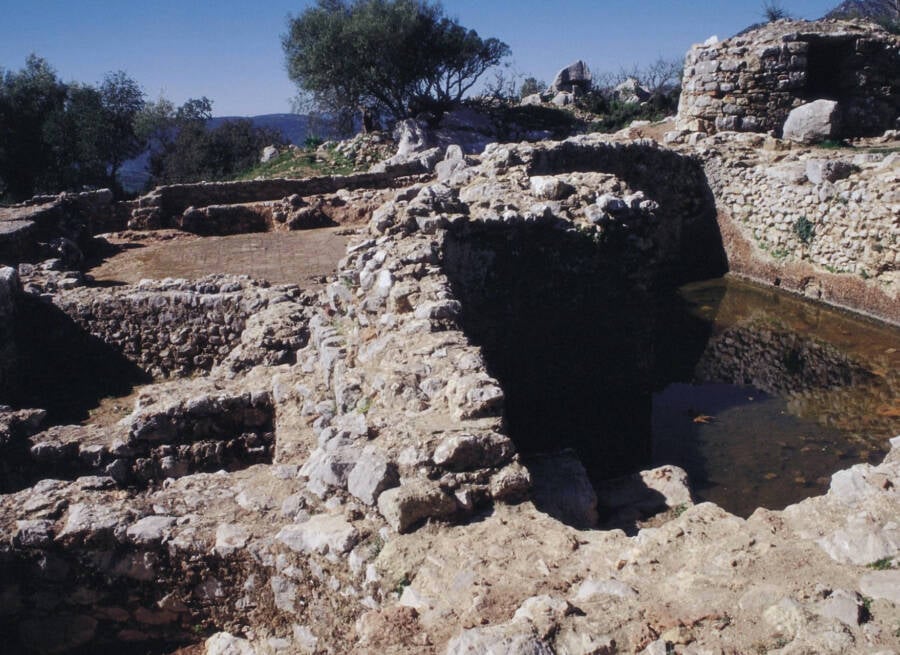More than 300 years after a farmer and amateur historian suggested that there were vast Roman ruins on his land in the hills of Ubrique, archaeologists have proven him right.

University of GranadaRuins of the Roman forum discovered on what was once farmland in the hills of Ubrique, Spain.
In the late 1700s, Spanish farmer Juan Vegazo suspected that the hints of buried ruins on his property in Ubrique were remnants of an ancient Roman forum. He ultimately purchased the surrounding land and began excavating it himself.
During his dig, Vegazo found Roman inscriptions and pieces of more ruins. Despite these significant discoveries, he was only able to do so much on his own and his findings went largely unnoticed for centuries.
Recently, archaeologists from the University of Granada reexamined Vegazo’s findings and launched a formal excavation of the site. Their goal was to confirm Vegazo’s claim that the land held the ruins of a Roman forum.
And to their delight, they indeed uncovered an expansive forum complex, complete with ceremonial sites, a mausoleum, baths, and defensive walls.
The discovery has thrilled archaeologists, who are excited to verify Vegazo’s centuries-old theory and uncover more about Roman influence and cultural fusion in southern Spain.
An 18th-Century Spanish Farmer Has A Hunch About Ancient Ruins On His Property

University of GranadaThe ruins of the ancient Roman forum found in Ubrique.
In the late 1700s, Juan Vegazo claimed that an ancient Roman forum lay beneath the dirt of a nearby hill called Cerro de la Mora in Ubrique, in the southern Spanish province of Cadiz.
At the time, excavations in Pompeii were underway, leading to interest in ancient archaeology across Europe.
Confident that his hunch was correct, Vegazo purchased the land and began excavating it for himself. During the dig, he discovered Roman inscriptions mentioning the name of 2nd-century Roman emperors as well as the city’s name, Ocuri.
In the following centuries, however, Vegazo’s discovery went largely unnoticed. It wasn’t until recently that archaeologists reanalyzed his findings and set out to confirm them for certain.
“The main objective of the excavation was to confirm the hypothesis put forward by the local scholar Juan Vegazo at the end of the 18th century that the central terrace of the hill known as the Cerro de la Mora was the site of the forum of the Roman city,” Professor Macarena Bustamante Álvarez and her colleagues from the University of Granada said in a statement from the university.
They discovered that, not only was this hill indeed home to Roman ruins, but it also contained remnants of a large forum complete with baths, a mausoleum, and defensive walls.
Archaeologists Unearth A Roman Forum In The Hills Of Ubrique

University of GranadaArchaeologists excavate the roman ruins unearthed in southern Spain.
On October 15, 2024, archaeologists from the University of Granada announced that they had discovered exactly what Juan Vegazo suspected: a large Roman structure.
When the archaeological team first arrived on site, they immediately identified the Roman structure’s central square, surrounded by a wall measuring roughly three feet high and about 52 feet long.
Furthermore, the team uncovered a large ceremonial site complete with a monumental altar, column shafts and bases, and statue pedestals. This structure likely served religious purposes and featured several water motifs, designs that blended both Roman and local beliefs.
“The excavations outline a space that is crucial for understanding the arrival and consolidation of the Romans in the southern Iberian Peninsula, as well as their hybridization with the communities that had already settled in the area,” the researchers said.

University of GranadaA piece of a Roman column found at the site in Spain.
Experts believe that the area surrounding the forum was inhabited until the 4th century C.E., based on coins found at the site. One of the coins contained a Christogram, a form of Christian iconography created by Constantine I in 312 C.E.
Researchers have also found evidence of the site’s ties to trade routes. North African goods, such as ceramics, show the flow of goods through the Spanish peninsula.
After its abandonment, the site was later inhabited during the medieval period, as demonstrated by the nearby ruins of a defensive structure from the period.
In the end, archaeologists are pleased to confirm what Juan Vegazo first claimed more than 300 years ago.
After reading about this ancient Roman forum, dive into the stories of some of the worst emperors of ancient Rome. Then, read all about why the Roman Empire collapsed.





